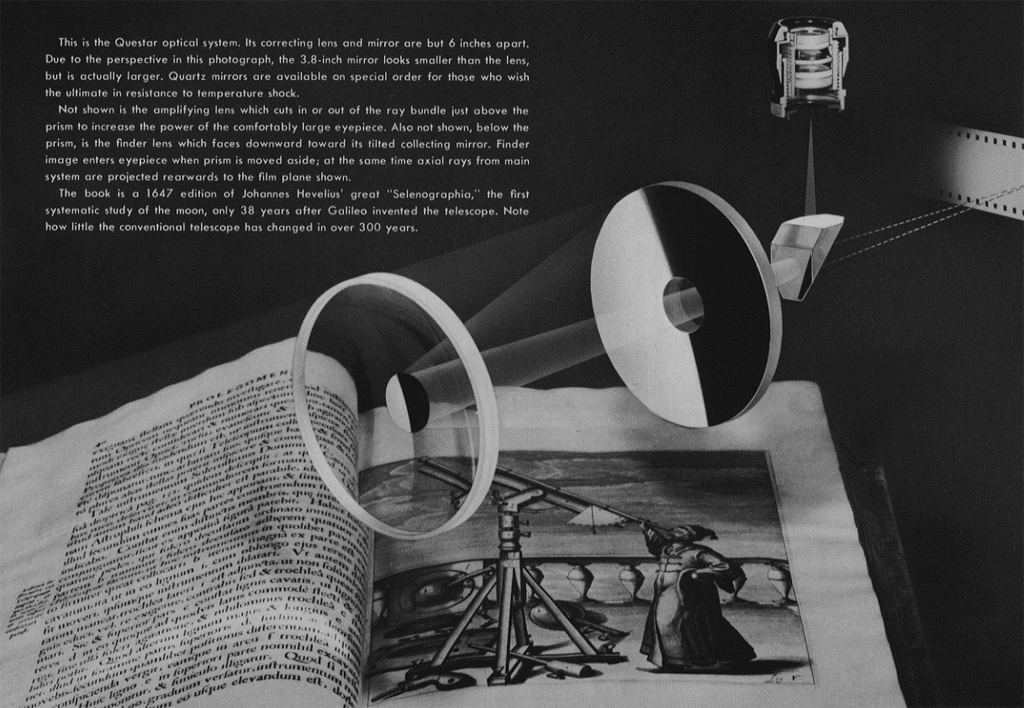Questar Distribution
![]() News
News ![]() Notes & Interesting Articles
Notes & Interesting Articles ![]() Overview
Overview ![]() Pricing
Pricing ![]() Products
Products ![]() Service or Repair
Service or Repair
Questar Telescopes ![]() LD Surveillance Systems
LD Surveillance Systems ![]() LD Microscopes
LD Microscopes ![]() Accessories
Accessories


Questar Optical System
These optics, including the types of prism incorporated in the Control Box of the Questar 3-½ telescopes, are exhibited at Company Seven's showroom museum collection.The illustration below is page 16 from a Questar catalog of November 1960 in Company Seven's archives.
 Above: "Questar Optical System" page 16 from the Questar catalog November 1960. Light enters the transparent Corrector Lens from the left, it is then reflected from the 3.8 inch diameter Primary Mirror at (right of center) forward to the Secondary Mirror (aluminized spot deposited onto inner surface of the Corrector), then back through the perforated Primary Mirror to the 90 degree Prism Diagonal, then then up to the eyepiece. (250,510 bytes) |
Text from the illustration:
Not shown is the amplifying lens which cuts in or out of the ray bundle just above the
The book is a 1647 edition of Johannes Hevelius' great "Selenographia," the first
The optics for Questar Corp. were produced at Cumberland Optics, a professional optics laboratory in Maryland, until 2024 when this facility closed. Here the optics were hand-matched to a very high standard, with each Corrector Lens and Primary Mirror set serial numbered. Standard antireflective and mirror coatings were applied at Cumberland Optics, while the more sophisticated coatings were contracted from expert facilities; these included generations of Broad-Band, and other special purpose coatings.
The optical tube assembly of a Questar should not be disassembled or tampered with. Nor should a Corrector Lens from one set be interchanged with the Primary Mirror of another. It may be possible for someone to swap components then reassemble a Questar telescope so that the image appearance may appear to be acceptable however, the results could likely not pass critical acceptance testing at Company Seven or at another professional optics laboratory.
The catadioptric optics of the early and mid-production Questar 3-½ were initially based on the Maksutov-Cassegrain design. This was satisfactory for use when these were being employed with eyepieces capable of magnifications up to about 200x. Years later the design was changed to a more classic Maksutov-Cassegrain arrangement that is capable of better performance especially when driven to higher magnifications. Also note some older Questar 3-½ telescopes have had their original optics set replaced with the newer arrangement at Questar Corp. or Company Seven.
This is the Questar catadioptric optical system. Its correcting lens and mirror are but 6 inches apart.
Due to the perspective in this photograph, the 3.8 - inch mirror looks smaller than the lens,
but is actually larger. Quartz mirrors are available on special order for those who wish
the ultimate in resistance to temperature shock.
prism to increase the power of the comfortably large eyepiece. Also not shown, below the
prism, is the finder lens which faxes downward towards its tilted collecting mirror. Finder
image enters eyepiece when prism is moved aside; at the same time axial rays from the main
system are projected rearwards to the film plane shown.
systematic study of the moon, only 38 years after Galileo invented the telescope. Note
how little of the convention(al) telescope has changed in over 300 years.
Contents Copyright 1960-2025 Company Seven and Questar Corp. All Rights Reserved

